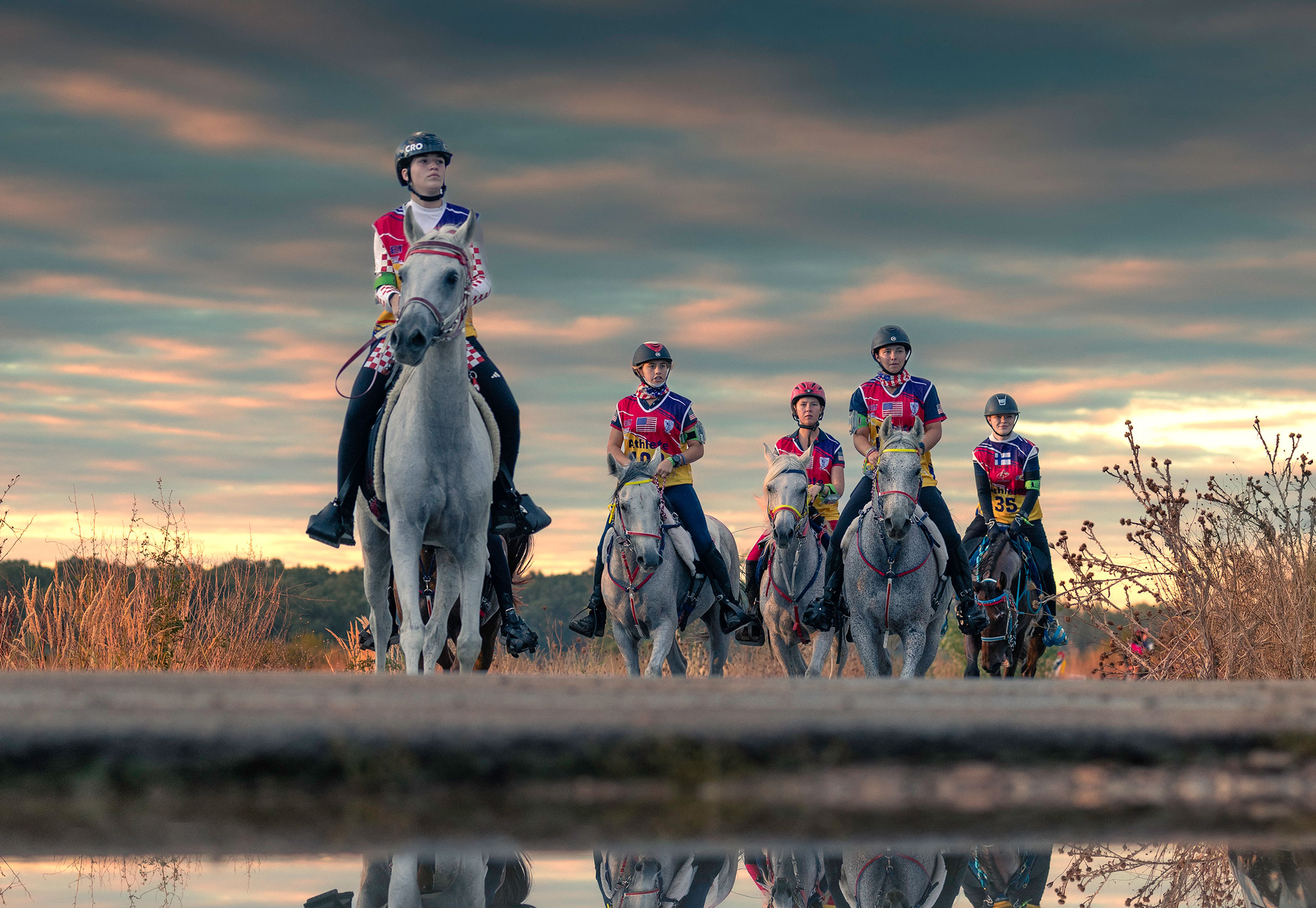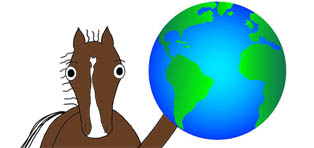Endurance-belgium.com
by Leonard Liesens, Belgium
March 16 2017
After my visit at Boudheib where I made this presentation, I'm proposing here a text a little more developed (I had time to think in the flight back :-)).
Your comments, suggestions, even critics (not too many and not to nasty please…) are welcome and most expected.
I’m asking all ‘good will’ people to participate at this project. Because our sport needs very strong actions supported by well-know and influential actors in endurance.
Let’s put aside our individualism and our old habits and let’s be innovative. All that for the salvation of our sport and our beloved horses.
I called my concept “Extreme Endurance”. But at the presentation, John Crandell told me that they already have something similar in the States. They call it “Cavalry Test”. Anyway, the name is not important…
Some findings (everybody have made hopefully the same) :
1. The speed keeps going up, while at the same time the weight of the riders goes down. We noticed - despite the FEI having claimed at all forums that the races must be more technical - that the championships are all flats those last years:
Samorin 2014(20.6km/h)…Verona2014(21.4km/h)…Sartilly2014(19.6km/h…the only technical race in the lot)…
Valeggio 2015(22.2km/h)…Samorin 2015(22.6km/h)… Santo Domingo 2015(22.4km/h)…
Negrepelisse 2016(20km/h)…Samorin 2016(23.6km/h)… Rio Frio 2016(23km/h)…
- 2. The number of what I’m calling the “Jockey-Riders” is raising. And don’t think that this phenomenon only takes place in the Gulf. We also have in Europe more juniors relying on their parents to condition the horses so they can ride at major rides. So these riders have not suffered on the long run with the horses they are riding; they hardly know them; they haven’t qualified them. So the risk is big as they don’t assume the responsibility of their companion welfare. They are followed all the way by the trainer and do what they asked to, but they do not listen to their horse - because sometimes they haven't learned to do do.
The horse is ridden like a bike, gas pedal to the ground, then delivered to the grooming team to get the horse “ready” for the vet inspection. After that, if the horse passes, that’s up the grooming team to do everything to “fix” it for the next faze. Exaggerating…not really… just a little maybe… or maybe not…
Where is the “horsemanship” is all that?
-
3. The crewing has become omnipresent. Water bottles every 5 km (this is the least as in the UAE, Boudheib excepted, water is dropped on the horse almost all the time). Horses not allowed to drink at water points. An extreme tension at the crew points because of the armada of stressed grooms, the cars, the excited riders; let’s not forget that a horse is a herd animal which by nature flies away from the danger.
At the vetgate tons of water are dropped on the horses. Like them entering into a water tunnel, those poor robot-horses, the light in their eyes having vanished since a long time, drilled like robots. They move in the water tunnel, getting a deluge of 100 litres per 10 meters ice water poured on their body.
The rider who has ran his horse into the ground rely on a plethoric number of grooms and vets to” do up” his mount, sometimes with unauthorized means. Horses visibly in distress are magically up and running the next stage. Terrible...
-
4. The "Completion" is not prized anymore. What counts is the victory at all costs. And the faster the last loop the better. “We have 30 minutes to pulse down”…
- 5. Not even writing about doping, fractures, cheating, chasing the horses with 4x4, etc...
Taking into account these findings, having got long discussions at Boudheib and having seen positive reactions, I think it’s time to stick our head above the parapet (found this on the internet J translation of “Getting out of the woods”…). I would appreciate that all riders and their entourage to consider this formula.
A very simple concept
The rider and his horse
Nothing else
- - Nobody is allowed to touch the horse. Nowhere (would that be with the hand, the foot or any part of the body, sic…). Would that be at the start of the fazes, at the crew points, at the vetgate, at the rest area. The only exception would be when the horse requires the farrier intervention. In all other cases, the slightest contact with the horse means the elimination. Crystal clear. No interpretation… The rider is falling and the horse needs to be caught… elimination. The bit or the rein breaks and someone comes to help…elimination. The riders let his/her horse go at the water point and he needs to be caught…elimination. No exception.
- - The ride manager will have to organise water points every 10km: water tanks for the horses, hay and alfalfa and maybe mash, water and Gatorade and snacks for the rider. The water point will be delimited by ribbons that spectators and grooms are not allowed to trespass. The rider willing to cool down his horse does so by dismounting or by dropping a sponge or a bucket in the water tank.
- - At the cooling down area(vetgate), each horse will have a designated place that will have been prepared by the grooms with buckets of water and all necessary equipment. The couple will head there to untack and cool down the horse. The rider will present his horse HIMSELF and trot his mount (a rider not able to trot for 80 meters is not a sport man and should not start the next faze). During that time the groom may collect the tack and saddle, wash it and bring it back to the resting area.
- - If the horse is vetting OK, the rider lead it to the resting area in his designated paddock. He will take care of his companion, massage him, give him access to the various feed THANN TAKE CARE OF HIMSELF (Horse’s first!).
- - When time is up, the riders will put the saddle and the tack and go for next loop. Nobody will have touched the horse. When the rider has been gone, the crew will prepare the paddock for the next faze or bring the whole stuff to the next vetgate (when it’s not a shamrock-like race).
- - At the finish, the rider should be allowed to run/walk beside his horse (why was it necessary to amend the regulation, forcing the rider to be on the horse…).
- Pulse at vetgate: 64BPM. Maximum presentation time: 10 minutes. Rest time: at least 45 minutes. Min weight : 75 kgs on all competition, also the qualifications.
- During the vetgate, we should come back to the motto “Fit to continue”, even at the last check. A horse not able to display his trot should be eliminated.
Sport aspects
- We are coming back to the fundamentals, the basics of endurance : the combined effort of the horse and the rider while keeping the competition spirit. Beating the trail, beating the opponents while preserving the welfare of the animal, while taking the greatest care of the horse because the ride is long and the first goal is to complete. It is a real race. The first crossing the line and fit to continue is the winner.
- The essential notion of “horsemanship”: schooling and training and conditioning the horse, riding the best way in all conditions, reading and respecting the trail, listening to the horse while going as fast as possible, being able to pace accordingly and taking into account that the race is long, taking the best care of his horse and respect him.
- This is actually nothing less than the Tevis (at Tevis the rider sees his crew only twice, at Robinson Flat and at Foresthill) or a classical Multidays in the USA.
- Is it necessary to ban the flat races? Not necessarily. Without crew the speed will reduce drastically. The formula has obviously to be tested.
- If the riders from the Middle East are keen to take the challenge, of course they are welcome. Some are already running the marathon or other human endurance tests.
- Everybody at the same level, dudes, sheikhs, princes, kings… all the same with their horse beating the trail.
- It would be obvious that the qualification system must return to the couple rider/horse.
- Last but not least, the nerve-blocking test should be developed.
Televisual aspects
Just an example (video amateur de Marijke Visser à Boudheib 2017)
https://m.youtube.com/watch?feature=share&v=urAM0XYJS4c
- Imagine the images at the television : the harmony between the rider and his horse when cruising in the nature ; the efficiency of the rider at the vetgate ; the beauty of happy horses at the finish line. Even the horsemanship displayed when the rider is jogging beside his horse at the finish. A much more positive picture than what has been showed those last years.
- The « Tour de France » in the Alps… similar. The Iron Man… the same...
**this post has been updated to Leonard's translation to English**
2025: The Year in Endurance
FEI.org - Full Article by Stacey Stearns Horsemanship and sportsmanship defined the year... The 2025 Endurance season showcased the sp...

-
Inside.fei.org 17 December 2020 The FEI Board took a series of key decisions on allocation, cancellation, and reopening of bids for FEI C...
-
Michael Pollard was one of the four winners of the 2025 Mongol Derby (Kathy Gabriel) Ca.News.yahoo.com - Full Article Annabel Grossman ...
-
BNA.bh - Full Article 17 Aug 2025 London, Aug. 17 (BNA): His Highness Shaikh Nasser bin Hamad Al Khalifa, Representative of His Majes...

